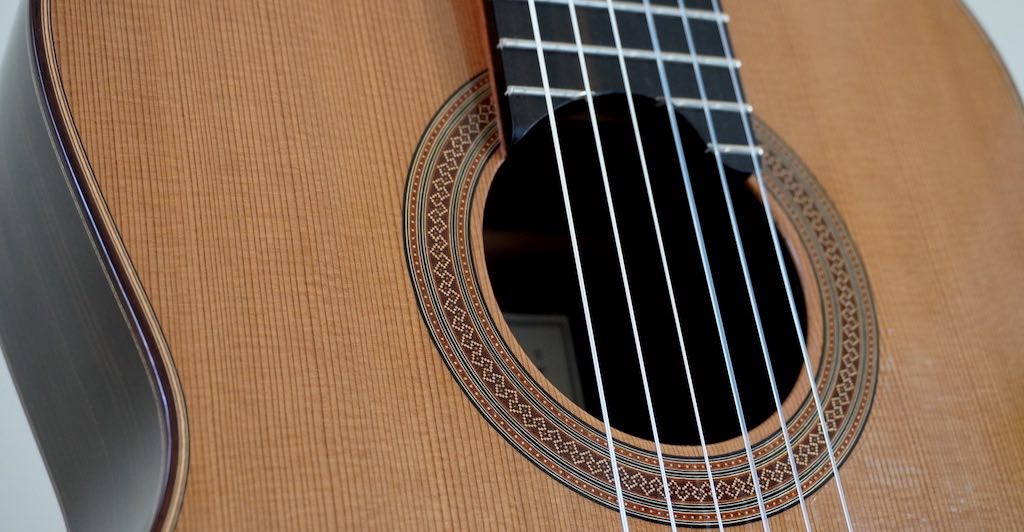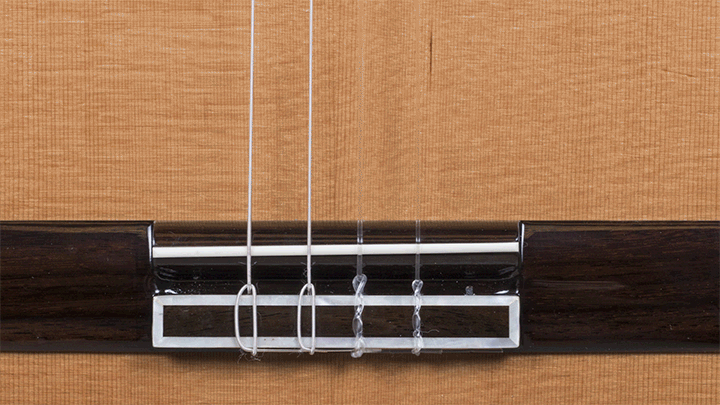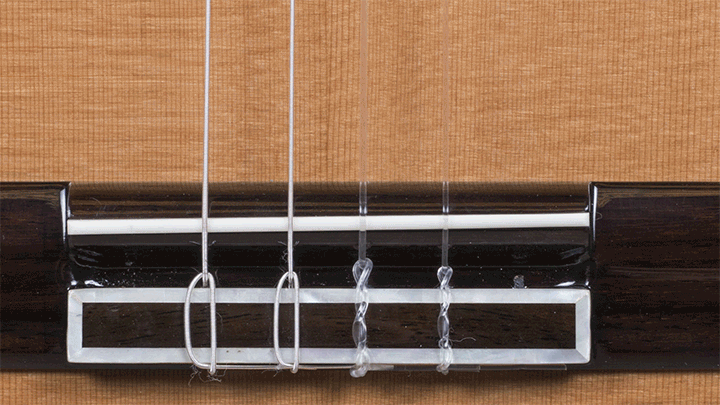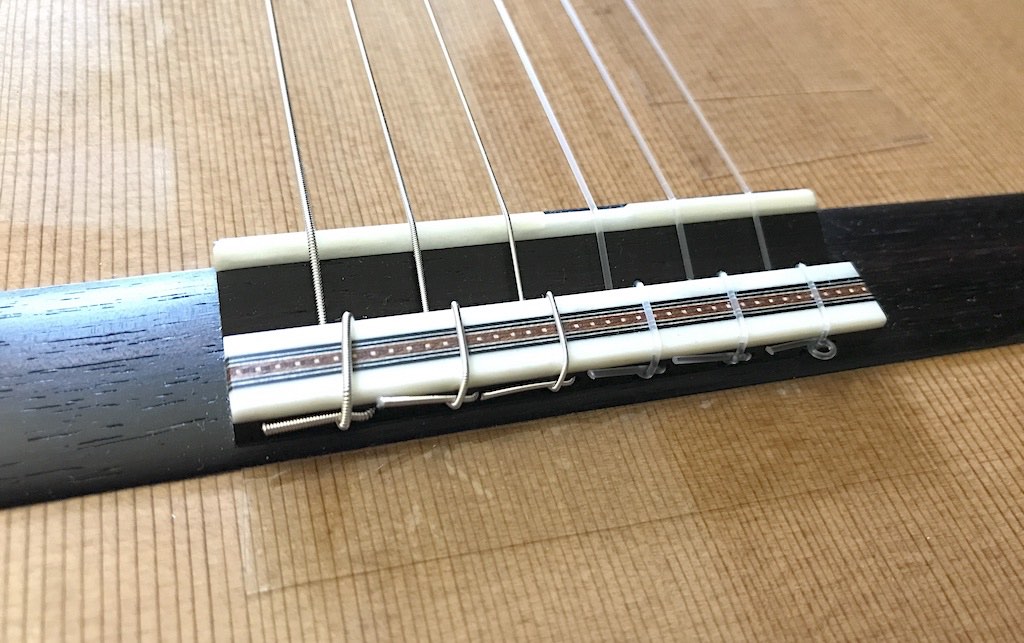
How to string a classical guitar
This is a lesson and guide to changing or replacing the strings on your classical or nylon string guitar. Classical and flamenco guitars have six strings, the three bass strings look like wound metal, they have a nylon core and a thin copper wire wrapped around the outside. The treble strings are a clear nylon composite material. Classical guitars need to have their strings changed regularly to get the best projection, tone, and playability. String replacement should happen quite often, especially if you practice a lot or are performing regularly. These days there are two types of tie blocks (on the bridge), a six-hole bridge and a twelve-hole bridge, we’ll look at both.
Quick tips before you begin
- Don’t take off all your strings at once – If you take off all your strings you can’t copy how they were previously tied when you re-string the guitar. Also, the saddle (the white bone or plastic in the bridge) is held in place by the strings so that can fall out if you take off all the strings.
- Change all of the strings (not just a broken one) – Strings ‘go dead’ when they loose their elasticity and get worn down by use. If you break a string it’s best to change all six.
- Re-string often – Beginner students can just replace the strings twice a year but more advanced guitarists should change them before each concert or as often as affordable.
- Protect your guitar – Have a cloth or thick paper to protect the top of your guitar as the tips of the strings can damage the finish or even the wood.
- Always double loop the high treble strings G, B, and E (see videos below). I actually only double loop B and E but as a general recommendation I would recommend it. If they come loose they can damage your guitar.
What Strings or Gear Do You Need?
You’ll need some nail clippers or wire cutters to clip the string ends. Of course, you’ll also need strings. I’d recommend D’Addario Pro Arte normal tension strings as a basic choice for beginners (or hard tension for intermediates) but you can see my review of classical guitar strings to see what I prefer.
Be sure you use nylon classical guitar strings, not steel strings. The tension used for steel-string guitars is much higher and can damage your classical guitar. Also remember that nylon classical guitar strings do not have ball-ends, that is, balls attachments on the end of the strings. Classical guitar strings require that you tie a self-fastening knot of sorts.
How to change classical guitar strings on a 6 hole bridge
Step by Step Gifs – How to replace classical guitar strings from this great article on Sweetwater. You should also watch the video below for more context but I love these gifs. I actually tuck the string up and under on other side but it totally does not matter.
Bass Strings

Treble Strings

Here’s a few videos on how to restring nylon guitar guitars with a basic 6-hole bridge. There are various ways to tie nylon strings on a guitar but if you are a beginner just choose one and go for it as they all work just fine.
Here is a video by the great Matthew Hinsley via Guitar Curriculum on their Youtube.
Here’s how to restring a classical guitar from Cordoba Guitars, I like the big demo with wood and rope.
How to tie guitar strings via String by Mail. Do not use an electric tuning drill, never even bring a drill into the same room as your guitar. Ever.
Another good link:
- Check out this article on how to string a classical guitar by Sweetwater. It has cool animated gifs of each step.
How to change classical guitar strings on a 12 hole bridge
How to tie classical guitar strings on a 12 hole bridge via Erez Perelman. FYI, I really don’t think you need to do an extra knot on the treble strings except maybe the 1st string. Some high tension strings it might be necessary for string 1 and 2. That said, you can air on the safe side if you want.
Here’s a picture of my tieblock on my Douglas Scott 12 hole bridge.






What about the “smooth end” of the 6th string (e. g. D’Addario Pro Arte) – use it at the bridge or at the headstock?
I cut it off afterward at the headstock.
Also on the subject of strings, I recently bought a used Esteve and it came with Diamond “tie blocks” on each string. What’s your opinion on these? Thanks Bradford!
Do you mean the string bridge beads? On a regular 6 hole bridge I think they are actually beneficial to the sound a little but not so much that I use them! I do seem to recall though that maybe they brighten up the sound just a touch but I’m sure it would be barely noticeable. All my recent guitars are 12 hole bridges these days so no longer need them.
Thanks, I’m glad to hear that. I actually would like to use them because it’s hard for me to get a good tight twist (have a touch of arthritis) and I worry about tugging too much on the bridge with these older guitars (which are actually a lot younger than I am!)
Have learned so much from your site! But just a little confusion with this post…..all three videos above showed a different method of securing the string at the headstock end! I guess as long as it’s under the first wrap as you turn the peg you’re good to go?
Yes, if it is under the string after the first turn it’s usually ok. I do sometimes double fix the 1st string if it’s a tiny carbon string or something or just to be safe.
I am a beginner and am changing my strings for the first time. I bought fretboard cleaner and conditioner that I want to use but your tutorial says not to take off all the strings at once. How can you give the fretboard a really good cleaning with strings on?
You could do have the strings at a time or just loosen the last three enough to do it and then replace. I don’t use any cleaners or conditioners, just a dry cloth wipe down.
found the information very helpful for a beginner. Thanks for doing this for all of us who need your help.
Hello Bradford, Just wanted to thank you for putting all of these great tutorials in one place, even the gifs at the end from Sweetwater… all are really so helpful! Thank you also for your great lessons and books that you offer for free and those you price so reasonably! I very much appreciate all that you do!
Best Regards,
Dory 😀
Glad it was helpful!